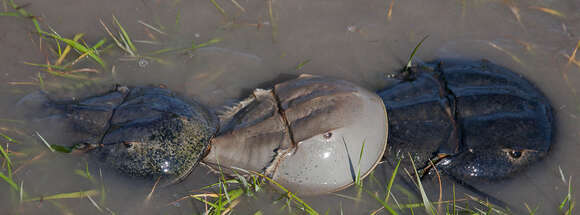Horseshoe crabs mating

Description:
Summary.mw-parser-output table.commons-file-information-table,.mw-parser-output.fileinfotpl-type-information{border:1px solid #a2a9b1;background-color:#f8f9fa;padding:5px;font-size:95%;border-spacing:2px;box-sizing:border-box;margin:0;width:100%}.mw-parser-output table.commons-file-information-table>tbody>tr,.mw-parser-output.fileinfotpl-type-information>tbody>tr{vertical-align:top}.mw-parser-output table.commons-file-information-table>tbody>tr>td,.mw-parser-output table.commons-file-information-table>tbody>tr>th,.mw-parser-output.fileinfotpl-type-information>tbody>tr>td,.mw-parser-output.fileinfotpl-type-information>tbody>tr>th{padding:4px}.mw-parser-output.fileinfo-paramfield{background:#ccf;text-align:right;padding-right:0.4em;width:15%;font-weight:bold}.mw-parser-output.commons-file-information-table+table.commons-file-information-table,.mw-parser-output.commons-file-information-table+div.commons-file-information-table>table{border-top:0;padding-top:0;margin-top:-8px}@media only screen and (max-width:719px){.mw-parser-output table.commons-file-information-table,.mw-parser-output.commons-file-information-table.fileinfotpl-type-information{border-spacing:0;padding:0;word-break:break-word;width:100%!important}.mw-parser-output.commons-file-information-table>tbody,.mw-parser-output.fileinfotpl-type-information>tbody{display:block}.mw-parser-output.commons-file-information-table>tbody>tr>td,.mw-parser-output.commons-file-information-table>tbody>tr>th,.mw-parser-output.fileinfotpl-type-information>tbody>tr>td,.mw-parser-output.fileinfotpl-type-information>tbody>tr>th{padding:0.2em 0.4em;text-align:left;text-align:start}.mw-parser-output.commons-file-information-table>tbody>tr,.mw-parser-output.fileinfotpl-type-information>tbody>tr{display:flex;flex-direction:column}.mw-parser-output.commons-file-information-table+table.commons-file-information-table,.mw-parser-output.commons-file-information-table+div.commons-file-information-table>table{margin-top:-1px}.mw-parser-output.fileinfo-paramfield{box-sizing:border-box;flex:1 0 100%;width:100%}} Description: Horseshoe crabs are marine arthropods that live primarily in and around shallow ocean waters on soft sandy or muddy bottoms. They occasionally come onto shore to mate. Horseshoe crabs resemble crustaceans, but belong to a separate subphylum, Chelicerata, and are closely related to arachnids, e.g. spiders and scorpions. The earliest horseshoe crab fossils are found in strata from the late Ordovician period, roughly 450 million years ago. During the breeding season, horseshoe crabs migrate to shallow coastal waters. Males select a female and cling onto her back. The female digs a hole in the sand and lays her eggs while the male fertilizes them. The female can lay between 60,000 and 120,000 eggs in batches of a few thousand at a time. Shore birds eat many of the eggs before they hatch. The eggs take about two weeks to hatch. The larvae molt six times during the first year. Unlike vertebrates, horseshoe crabs do not have hemoglobin in their blood, but instead use hemocyanin to carry oxygen. Because of the copper present in hemocyanin, their blood is blue. (Wikipedia) I am not sure what is going on here but their is a French phrase that may apply. Date: 14 June 2013, 16:21. Source: HSCrabMating1.jpg Uploaded by FunkMonk. Author: Paul VanDerWerf.
Included On The Following Pages:
- Life (creatures)
- Cellular (cellular organisms)
- Eukaryota (eukaryotes)
- Opisthokonta (opisthokonts)
- Metazoa (Animal)
- Bilateria
- Protostomia (protostomes)
- Ecdysozoa (ecdysozoans)
- Arthropoda (arthropods)
- Chelicerata (chelicerates)
- Merostomata (Merostomes)
- Xiphosurida (horseshoe crabs and relatives)
- Limulina
- Limulidae (horseshoe crabs)
- Limulus
- Limulus polyphemus (American Horseshoe Crab)
This image is not featured in any collections.
Source Information
- license
- cc-by-3.0
- copyright
- Paul VanDerWerf
- creator
- Paul VanDerWerf
- source
- Flickr user ID pavdw
- original
- original media file
- visit source
- partner site
- Wikimedia Commons
- ID


